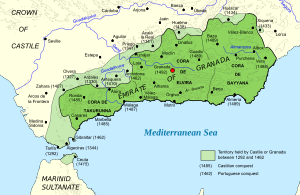Battle of Linuesa
This article includes a list of general references, but it lacks sufficient corresponding inline citations. (December 2017) |
| Battle of Linuesa | |||||||
|---|---|---|---|---|---|---|---|
| Part of the Reconquista | |||||||
 Map of the Nasrid Emirate of Granada. | |||||||
| |||||||
| Belligerents | |||||||
|
|
| ||||||
| Commanders and leaders | |||||||
|
Muhammed VI | |||||||
| History of Spain |
|---|
 |
| Timeline |
The Battle of Linuesa was an action fought on 21 December 1361 in the city of Huesa, Kingdom of Jaén (present-day Province of Jaén, Spain). The battle was fought between the Kingdom of Castile and the forces of the Emirate of Granada. The battle resulted in a victory for the forces of the Kingdom of Castile.
The Castilian forces were commanded by
Context
The
The battle
When Diego García de Padilla, Grand Master of Calatrava heard news about the Muslim invasion of Cazorla, and of the havoc being raised in Peal de Becerro, he gathered his forces and gave pursuit.[1]
The Castilian-Leonese troops gained control over a river crossing at Guadiana Menor with the intent of taking advantage of the fact that the Muslim forces would have to cross the river at the crossing to return to their lands. The battle commenced on 21 December 1361.
The Muslim troops arrived at the pass previously occupied by the
Aftermath
When King
Further, once in power of the treasure handed over, the king failed to make good on the promised reward money. The breaking of this promise doubtless angered
A few months later, the same Castilian army led by the same commanders was defeated by Muslim troops at the Battle of Guadix which was fought in winter of the year 1362.
References
Footnotes
- ^ López de Ayala, Pero; Pero López de Ayala (1779). "VIII". Cronicas de los reyes de Castilla: Don Pedro, Don Enrique II, Don Juan I, Don Enrique III. Madrid: en la imprenta de Don Antonio de Sancha. p. 335.
linuesa 1361 enriquez.
- ^ López de Ayala, Pero; Pero López de Ayala (1779). "VIII". Cronicas de los reyes de Castilla: Don Pedro, Don Enrique II, Don Juan I, Don Enrique III. Madrid: en la imprenta de Don Antonio de Sancha. p. 336.
linuesa 1361 enriquez.
- ISBN 978-84-9704-274-1.
Bibliography
- Arana de Varflora, Fermín; Fermín Arana de Varflora (1791). Hijos de Sevilla ilustres en santidad, letras, armas, artes, ò dignidad (1ª ed.). Sevilla: En la imprenta de Vazquez e Hidalgo.
- Argote de Molina, Gonzalo; Gonzalo Argote de Molina (1588). Fernando Díaz (ed.). Nobleza del Andaluzia (1ª ed.). Sevilla.
- de Ayala Martínez, Carlos (2000). "Órdenes militares y frontera en la Castilla del siglo XIV". En la España Medieval (23). Madrid: Universidad Complutense: Departamento de Historia Medieval y Servicio de Publicaciones: 265–291. ISSN 0214-3038. Retrieved 15 May 2010.
- Díaz Martín, Luis Vicente (2007). Pedro I el Cruel (2ª ed.). Gijón: Ediciones Trea S.L. ISBN 978-84-9704-274-1.
- López de Ayala, Pero; Pero López de Ayala (1779). Cronicas de los reyes de Castilla: Don Pedro, Don Enrique II, Don Juan I, Don Enrique III. Madrid: en la imprenta de Don Antonio de Sancha. p. 334.
linuesa 1361 enriquez.
- Mata Carriazo y Arroquia, Juan de (2002). Catalogación Universidad de Sevilla. Secretariado de Publicaciones (ed.). En la frontera de Granada. Granada: Editorial Universidad de Granada. Campus Universitario de Cartuja. Granada. ISBN 84-338-2842-8.
See also
- Peter I of Castile
- Enrique Enríquez "el Mozo"
